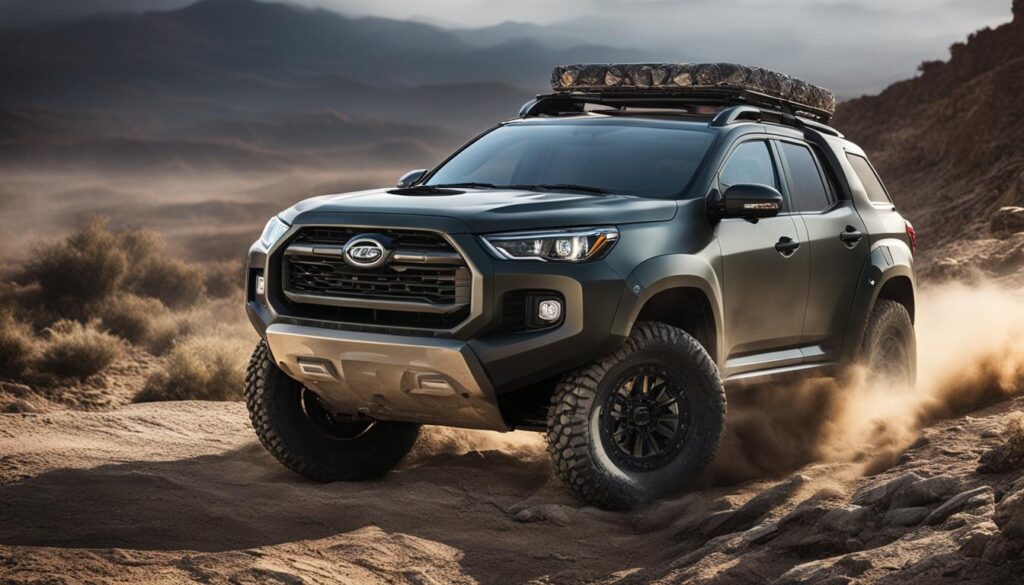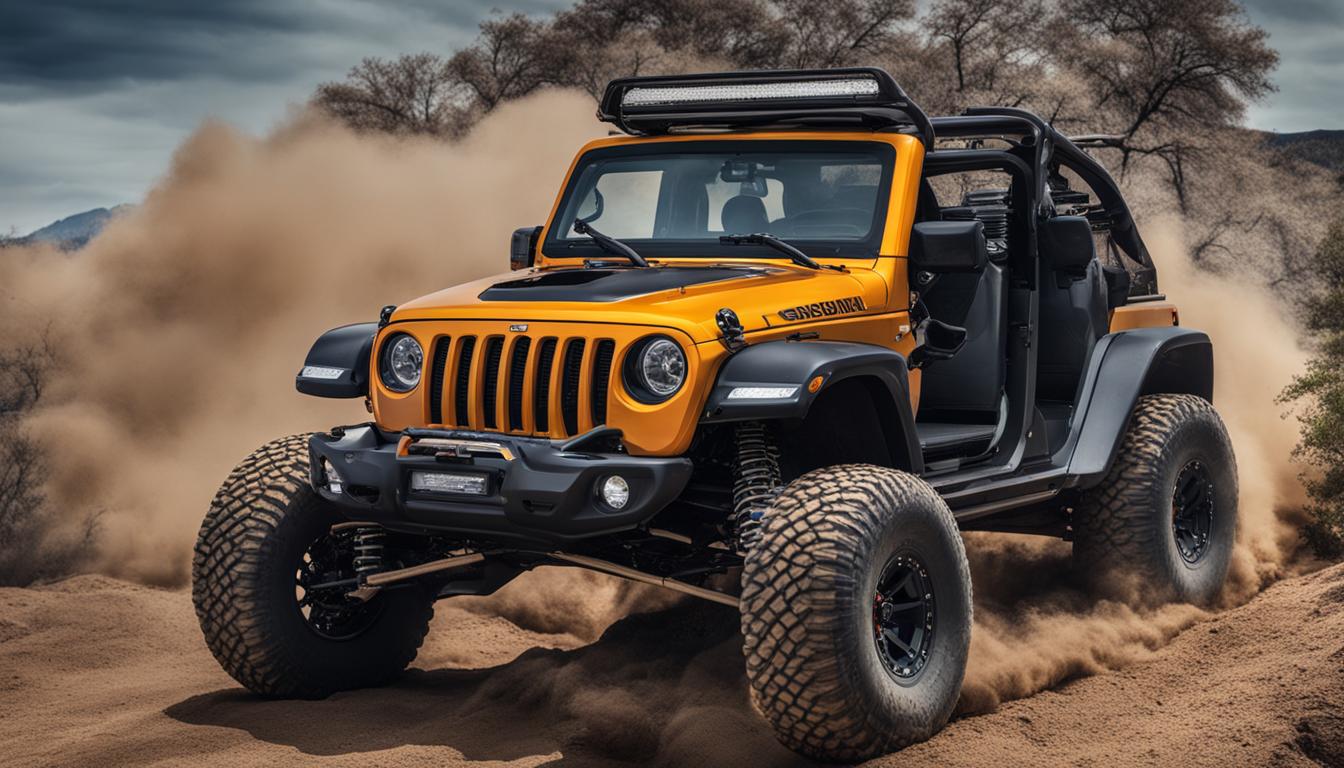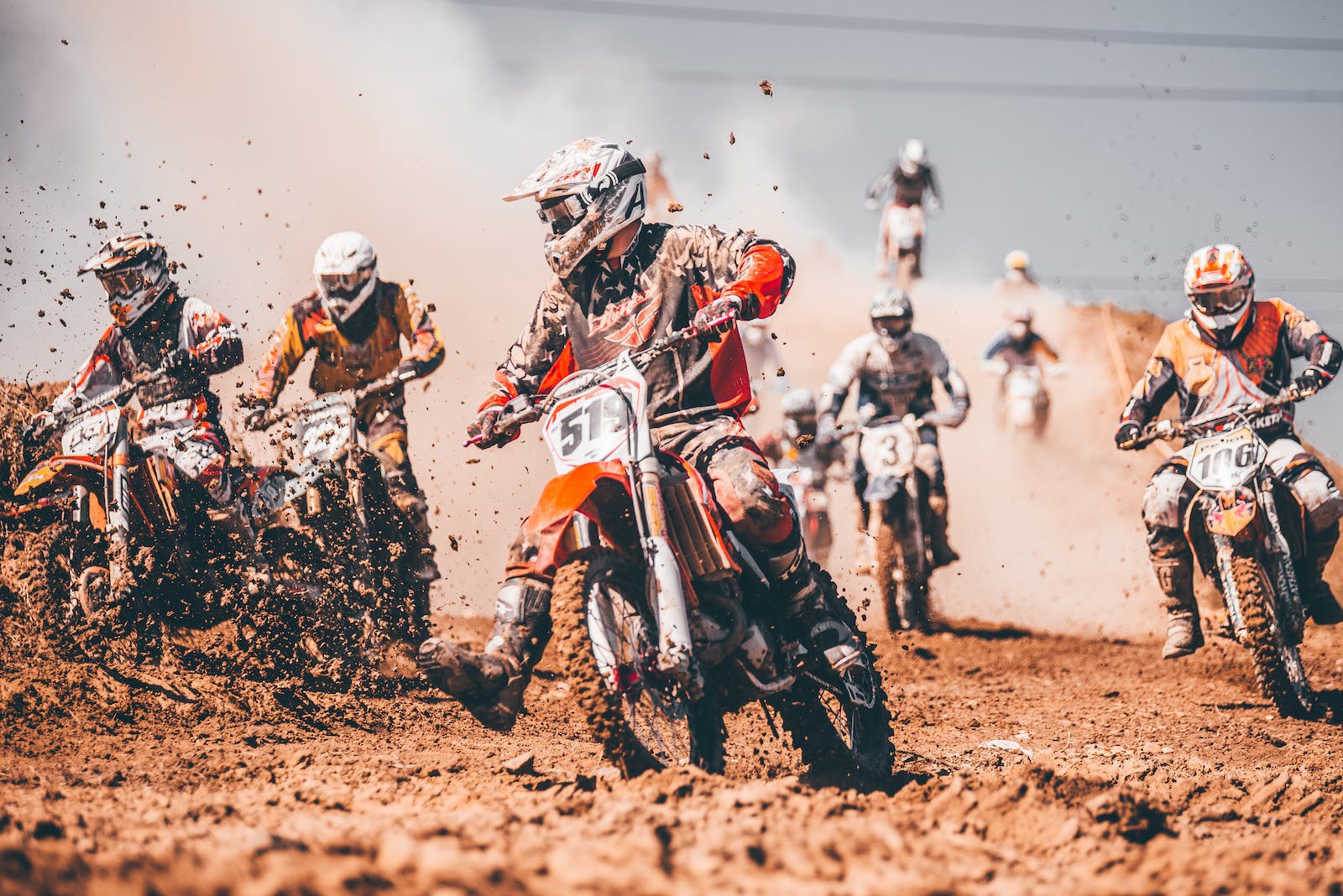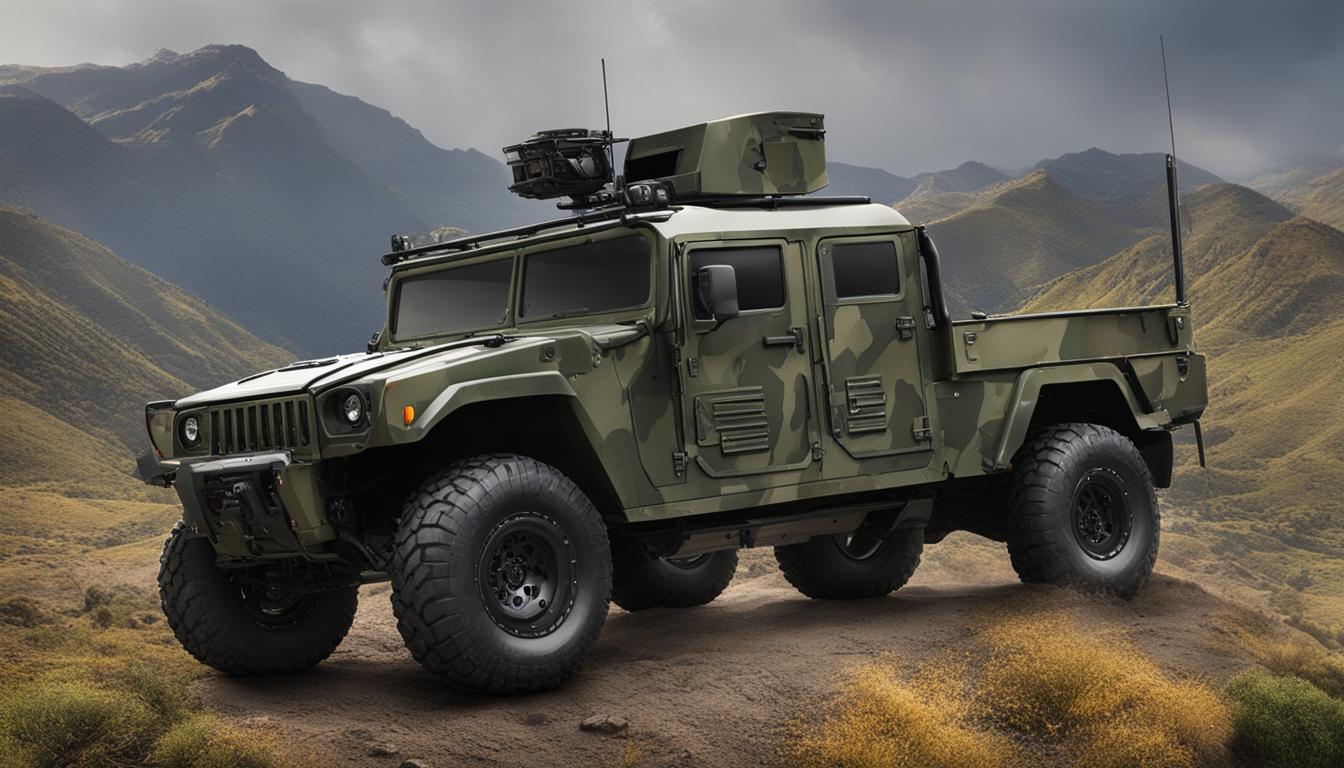In off-road suspension, there are two main types of springs commonly used: coiled springs and air springs. While both have their advantages and disadvantages, they serve different purposes in off-road vehicles. Coiled springs offer superior ride quality, customization options, and weight savings. On the other hand, air springs provide adjustability, leveling capabilities, and improved stability. Understanding the differences between these two types of springs is essential in making an informed decision for your off-road adventures.
Key Takeaways:
- Coiled springs provide superior ride quality and customization options in off-road vehicles.
- Air springs offer adjustability, leveling capabilities, and improved stability.
- Coiled springs are lighter than leaf springs, resulting in weight savings for the vehicle.
- Air springs can be prone to failure and are more expensive to repair or replace.
- The choice between coiled springs and air springs depends on individual needs, preferences, and vehicle requirements.
Coiled Springs (The Pros)
Coiled springs have long been favored in off-road suspension systems due to their numerous advantages. One of the key benefits of coiled springs is their ability to provide a superior ride quality, particularly in the front suspension system. Each wheel can independently handle the conditions of the road or terrain, allowing for a smoother and more controlled ride.
Another advantage of coiled springs is their customizable nature. Off-road enthusiasts can choose from different spring rates to fine-tune the ride quality and performance of their vehicles. This flexibility allows for a personalized driving experience tailored to individual preferences and specific off-road requirements.
Additionally, coiled springs offer weight savings compared to other suspension systems, such as leaf springs. The lighter weight contributes to improved handling and maneuverability, enhancing the overall off-road performance of the vehicle.
Increased Ride Quality and Customization
Coiled springs offer a superior ride quality, especially in the front suspension system, as each wheel can independently handle the conditions of the road or terrain.
Weight Savings for Improved Performance
Coiled springs are often lighter than leaf springs, resulting in weight savings for the vehicle, which contributes to improved handling and maneuverability.
Customizable Nature for Personalized Experience
Coiled springs allow for more movement in the suspension system, providing increased off-road agility. They also offer the option to choose from different spring rates for customizing and fine-tuning ride quality and performance.
| Advantages of Coiled Springs |
|---|
| Superior ride quality |
| Customizable nature |
| Weight savings |
Coiled Springs (The Cons)
While coiled springs offer numerous benefits in off-road suspension systems, they also have some limitations to consider. Firstly, in heavy-duty applications such as larger trucks, coiled springs may not provide the stability required for load carrying tasks compared to leaf springs. This can lead to compromised performance and potential safety issues. Additionally, the cost of coil spring suspension systems can be higher than traditional leaf springs, making them less cost-effective in certain situations. It’s essential to weigh the advantages against these drawbacks when considering the use of coiled springs in off-road vehicles.
Coiled springs also require regular maintenance to ensure optimal performance. Over time, these springs may sag or lose their original spring rate, resulting in decreased ride quality and compromised stability. It’s crucial to inspect and replace worn-out or damaged coiled springs promptly to maintain the desired suspension performance. Additionally, the installation of coil spring suspension systems may require modification to the vehicle’s frame or chassis, adding extra complexity and potential costs to the process.
Another consideration when using coiled springs in off-road vehicles is the limited availability of aftermarket options compared to leaf or air springs. This can affect the ease of customization and the availability of specific spring rates or designs to suit individual preferences or vehicle requirements. It’s important to research and consult with knowledgeable experts to ensure compatibility and feasibility before opting for coiled springs in an off-road suspension system.
Air Springs (The Pros)
Air springs offer unique advantages in off-road suspension systems. They provide a range of benefits that make them a popular choice for off-road enthusiasts. Here are some key advantages of using air springs in off-road vehicles:
- Adjustability: Air springs allow for easy adjustment of the vehicle’s ride height, offering flexibility for different terrains and driving conditions. This adjustability ensures optimal ground clearance and helps prevent bottoming out on rough terrains.
- Leveling capabilities: Air springs can level the vehicle, compensating for uneven loads or towing situations. This feature helps improve stability and control, particularly when hauling heavy loads or towing trailers.
- Improved stability: Air springs provide enhanced stability by minimizing body roll and sway. This is particularly beneficial during off-road adventures where maintaining control and stability are crucial.
- Reduced wear and tear: Air springs absorb shocks and vibrations, reducing the strain on other suspension components. This helps prolong the lifespan of the overall suspension system and reduces the risk of damage to other vehicle parts.
- Comfortable driving experience: Air springs offer a smoother and more comfortable driving experience by minimizing the impact of bumps and dips on the road. They absorb more of the road’s imperfections, resulting in a more enjoyable ride.
Overall, air springs provide advanced adjustability, leveling capabilities, improved stability, and a comfortable driving experience, making them a valuable component in off-road suspension systems.
Quote:
“Air springs offer superior adjustability and leveling capabilities, providing optimal ground clearance and stability for off-road vehicles.” – Off-Road Adventures Magazine
Table: Air Springs vs. Coiled Springs
| Feature | Air Springs | Coiled Springs |
|---|---|---|
| Adjustability | High | Low |
| Leveling Capabilities | Excellent | N/A |
| Stability | Improved | Good |
| Ride Quality | Smooth | Superior |
| Customization Options | Varied | Extensive |
| Weight Savings | N/A | Significant |
The table above highlights the key differences between air springs and coiled springs in off-road suspension systems. While air springs excel in adjustability, leveling capabilities, and ride comfort, coiled springs offer superior customization options and weight savings.
Air Springs (The Cons)
While air springs offer unique advantages in off-road suspension systems, it’s important to consider their drawbacks as well. One potential concern is the possibility of air spring failure. Punctures, tears, or degradation of the rubber construction can lead to compromised performance or complete system failure. Additionally, air lines and fittings are vulnerable to leaks, which can also result in system failure and require costly repairs.
Another aspect to consider is the higher cost associated with air springs compared to other suspension components. If an air spring needs to be repaired or replaced, it can be more expensive than alternatives such as coiled springs or leaf springs. This cost factor should be taken into account when considering the long-term maintenance and potential repair needs of an off-road vehicle.
Dependence on a functioning air compressor is another potential drawback of air springs. If the air compressor fails, the system may not be able to operate effectively, leaving the vehicle inoperable until the compressor is repaired or replaced. This reliance on an additional component adds a layer of complexity and potential vulnerability to the suspension system.
| Drawbacks of Air Springs | Countermeasures |
|---|---|
| Potential for air spring failure due to punctures, tears, or degradation of the rubber construction | Regular inspection and maintenance of air springs, including checking for signs of damage or wear. Prompt repair or replacement of any compromised air springs. |
| Air lines and fittings vulnerable to leaks | Regular inspection of air lines and fittings. Ensuring proper sealing and addressing any leaks immediately. |
| Higher cost compared to other suspension components | Considering the long-term maintenance and potential repair costs when budgeting for an off-road vehicle equipped with air springs. |
| Dependence on a functioning air compressor | Regular maintenance and inspection of the air compressor to ensure its proper functioning. Having a backup air compressor or alternative suspension system available as a contingency plan. |
Despite these disadvantages, air springs still offer valuable benefits in terms of adjustability, leveling capabilities, and improved stability in off-road vehicles. As with any suspension component, regular maintenance and prompt addressing of issues can help mitigate potential problems and ensure optimal performance.
Leaf Springs
Leaf springs have been a traditional suspension system in off-road vehicles, known for their durability and load-bearing capabilities. They consist of multiple layers of curved metal strips, called leaves, stacked on top of each other and held together by a center bolt. Leaf springs are simple, reliable, and highly effective at stabilizing and handling weight, making them ideal for heavy-duty applications.
One of the key advantages of leaf springs is their ability to spread the load of the vehicle over a broad area. This distribution of weight allows leaf springs to handle heavy loads without causing excessive sagging or compromising stability. It makes leaf springs advantageous in load-bearing applications such as hauling or towing, where maintaining a level ride height and stability is crucial.
| Advantages of Leaf Springs | Disadvantages of Leaf Springs |
|---|---|
|
|
Leaf springs are known for their durability and ability to handle heavy loads, making them a popular choice in off-road vehicles. However, their limited customization options and poor ride quality on rough terrains can be a drawback for those seeking a smoother and more adjustable suspension system.
Overall, leaf springs are a reliable and robust suspension option, particularly for off-road vehicles that prioritize load carrying and stability. However, their limitations in terms of ride comfort and customization may lead some off-road enthusiasts to explore alternative suspension systems such as coiled springs or air springs.
Coil Springs vs. Air Springs: Comparison
When choosing the right suspension for your off-road adventures, it’s important to compare the advantages and disadvantages of coil springs and air springs. Both types have unique characteristics that cater to different needs and preferences.
Coil Springs:
Coil springs offer superior ride quality and customization options. They provide a smoother and more controlled ride, especially in the front suspension, as each wheel can independently adapt to the terrain. Coil springs also offer the flexibility to choose from different spring rates, allowing for fine-tuning of ride quality and performance. Additionally, they are lighter than leaf springs, resulting in weight savings for the vehicle.
Air Springs:
Air springs, on the other hand, provide adjustability and improved stability. They can be adjusted to different ride heights, allowing for better ground clearance or achieving a lower profile. Air springs also offer leveling capabilities, ensuring a balanced suspension regardless of load or terrain. Moreover, they help reduce wear and tear on other suspension components, providing a more comfortable driving experience.
| Coil Springs | Air Springs |
|---|---|
| Superior ride quality | Adjustability |
| Customization options | Leveling capabilities |
| Lightweight | Improved stability |
Ultimately, the choice between coil springs and air springs depends on the specific needs of your off-road vehicle. If you prioritize ride quality and customization, coil springs may be the better option. However, if adjustability and leveling capabilities are more important to you, air springs might be the ideal choice. Consider factors such as the terrain you’ll be encountering, desired ride comfort, and load-bearing requirements when making your decision. Consulting with experts and conducting thorough research will help you choose the suspension system that best suits your off-road adventures.
How to Choose the Right Suspension for Your Off-Road Adventures
When it comes to off-road adventures, selecting the right suspension system can greatly enhance your vehicle’s performance and overall experience. With the choice between coiled springs and air springs, it’s important to consider factors such as ride quality, customization options, adjustability, and stability. Finding the perfect suspension for your off-road needs requires careful evaluation and consideration.
Coiled springs, known for their superior ride quality and customization options, are a popular choice among off-road enthusiasts. These springs provide a smoother and more comfortable ride, especially over rough terrains. With the ability to choose from different spring rates, you can fine-tune your vehicle’s suspension to match your specific preferences and requirements. Additionally, coiled springs are often lighter than other suspension systems, resulting in improved fuel efficiency and handling.
On the other hand, air springs offer a unique set of advantages for off-road adventures. These springs provide adjustability, allowing you to easily change the ride height of your vehicle to accommodate different terrains or clearance requirements. Air springs also offer leveling capabilities, ensuring that your vehicle remains balanced and stable even when carrying heavy loads. Furthermore, the ability to adjust the air pressure in the springs provides added control and comfort, especially during extreme off-road maneuvers.
Choosing between coiled springs and air springs ultimately depends on your specific needs and preferences. Consider factors such as the type of terrain you’ll be traversing, the desired ride comfort, and the load-bearing requirements of your vehicle. Consulting with experts in off-road suspension systems and conducting thorough research can provide valuable insights to help you make an informed decision. Remember, selecting the right suspension is key to maximizing the performance and enjoyment of your off-road adventures.

Conclusion
Understanding the difference between coiled springs and air springs is crucial when considering off-road suspension options. Coiled springs provide superior ride quality, customization options, and weight savings, making them a popular choice for off-road enthusiasts. On the other hand, air springs offer adjustability, leveling capabilities, and improved stability, making them a favored option for those seeking enhanced performance.
When deciding between coiled springs and air springs, it’s important to consider factors such as ride comfort, terrain requirements, and load-bearing capacity. Coiled springs excel in providing a smooth ride and allowing for personalized adjustments, while air springs offer the advantage of adaptability and leveling. By assessing these factors based on individual needs and preferences, off-road enthusiasts can select the ideal suspension system for their adventures.
The choice between coiled springs and air springs ultimately boils down to the specific requirements of the off-road vehicle and the desires of the driver. Whether seeking the utmost comfort, versatility, or stability, both options offer unique benefits. By carefully evaluating the benefits of coiled springs and air springs, off-road enthusiasts can make an informed decision, ensuring an optimized and enjoyable off-road experience.
FAQ
What are the advantages of coiled springs in off-road suspension?
Coiled springs offer superior ride quality, customization options, and weight savings.
Are there any limitations to using coiled springs in off-road vehicles?
Coiled springs may not provide the stability required for heavy-duty load carrying tasks and can be more expensive compared to other suspension options.
What are the benefits of using air springs in off-road suspension?
Air springs provide adjustability, leveling capabilities, and improved stability in off-road vehicles.
What are the drawbacks of using air springs in off-road vehicles?
Air springs can be vulnerable to punctures, leaks, and require a functioning air compressor. They can also be expensive to repair or replace.
What are the advantages of leaf springs in off-road suspension?
Leaf springs are known for their durability, load-bearing capabilities, and simplicity.
How do coiled springs and air springs compare in off-road suspension?
Coiled springs offer superior ride quality and customization options, while air springs provide adjustability and leveling capabilities.
How do I choose the right suspension for my off-road adventures?
Consider factors such as ride quality, customization options, adjustability, and stability. Consult with experts and conduct research to make an informed decision.
 Skip to main content
Skip to main content


